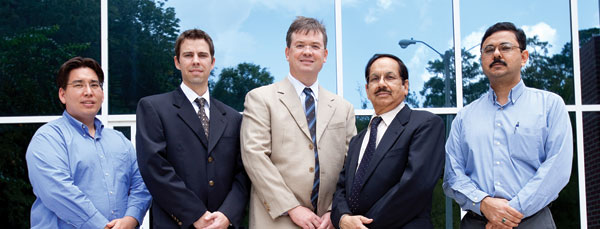Extracts

Surgeons, Particle Engineers Team Up On New Breast Cancer Treatments
A University of Florida medical and engineering team is developing new ways to deliver treatment to breast cancer patients.
The researchers recently received three U.S. Department of Defense Breast Cancer Concept Awards and a research foundation grant totaling nearly $600,000 to continue their three potential delivery methods that may one day allow doctors to target tumors in hard-to-reach places without damaging healthy cells nearby. All three projects rely on nanotechnology.
“Right now what we do is we image cancer, and then we design a treatment for it,” said surgeon Stephen Grobmyer, who is also a member of the UF Shands Cancer Center. “With theranostics, which nanotechnology is enabling, you can combine the diagnosis and treatment all into one modality.”
Landenberger Research Foundation has awarded Grobmyer $250,000 for two years.
One delivery method the team will investigate would require attaching treatment or imaging nanoparticles to glucose molecules and injecting the combined materials into the patient. Because cancer cells consume much more glucose than healthy ones do, tumors will take in many of the glucose cells and accompanying nanoparticles. Grobmyer and Scott Brown, a research assistant scientist in the College of Engineering’s Particle Engineering Research Center, are co-principal investigators on this project.
Another potential method would envelop nanoparticles inside malignant cells that have been removed from the patient and treated with radiation so they cannot reproduce. These cells would then be injected back into the patient. Data from previous studies show malignant cells within a patient find and attach themselves to active tumors, thus delivering any treatment or imaging nanoparticles they are carrying.
Brown, the principal investigator on this project, said the method could be especially helpful for patients with cancers that have just begun to metastasize. He is hopeful some of the reinjected tumor cells would find small groups of active malignant cells growing in the patient, ones too small to be effectively targeted by traditional imaging methods for imaging or therapy.
“Right now a problem is detection. If you have metastatic disease, basically it’s a waiting game,” he said. “You wait until you can actually get something to show up on a PET, CT or an MRI. But with this, if it’s effective, any patient who gets a tumor removed who may be at risk for metastatic disease may just take an injection and later undergo whole body imaging.”
Deactivated tumor cells from cancer patients have been used in previous research on cancer vaccine development, but using them for treatment delivery is a novel approach, Grobmyer said.
“If you change your approach and say, ‘OK, we’re not going to modify the particle but we’re going to use the patient’s own tumor to deliver the particles,’ it might be a way to get around some of the issues related to delivery,” he said.
The third project proposes using polyhydroxy fullerenes, soccer-ball-shaped carbon molecules modified by UF engineers, to deliver nanoparticles to tumors for treatment and magnetic resonance imaging.
“The beauty of the nanotechnology is you separate the delivery from the treatment,” Grobmyer said. “The treatment actually becomes the easy part, in a way, because we can kill cancer cells a bunch of ways. We just have to be able to specifically get the material we want there.”
The Department of Defense funded only about 5 percent of the 1,238 Concept Award applications it received. In addition, the Philadelphia-based Margaret Q. Landenberger Research Foundation has awarded Grobmyer $250,000 for two years.